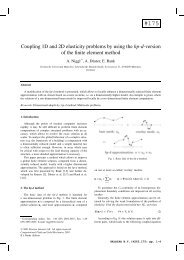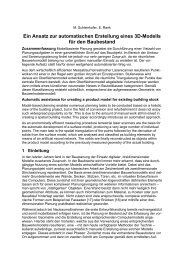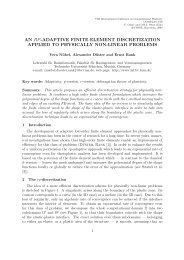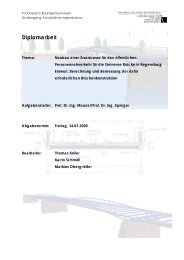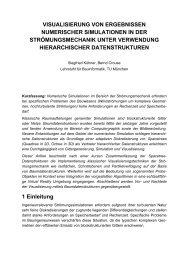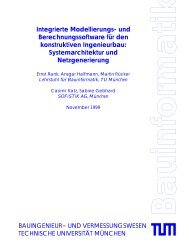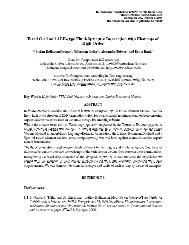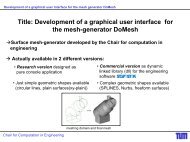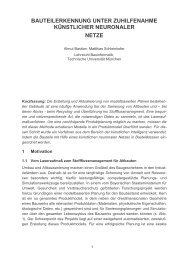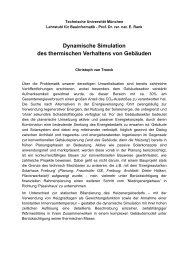Computational engineering for wind-exposed thin-walled structures
Computational engineering for wind-exposed thin-walled structures
Computational engineering for wind-exposed thin-walled structures
Create successful ePaper yourself
Turn your PDF publications into a flip-book with our unique Google optimized e-Paper software.
6 Ansgar Halfmann et al.<br />
immediately a constant inowvelocity<br />
ofU1 = 10 m/s being equivalent<br />
to a Reynolds number of Re L =50.<br />
As a consequence the structural oscillations<br />
are induced by the saltus<br />
of the uid velocity and reach a<br />
stationary de<strong>for</strong>mation state after a<br />
certain time. Fig. 10 shows again the<br />
displacement of the upper boundary<br />
of the plate <strong>for</strong> various timestep<br />
sizes. The interface discretizations<br />
comply to the grids pictured in<br />
Fig. 5. Only minor distinctions could<br />
be identied <strong>for</strong> the dierent time<br />
discretizations. Furthermore, the in-<br />
uence of the spatial interface discretization<br />
was investigated using<br />
the grids shown in Fig.11 and per<strong>for</strong>ming<br />
an uni<strong>for</strong>m renement of<br />
two levels <strong>for</strong> the CSD grid whereas<br />
the mesh <strong>for</strong> the uid domain remains<br />
unchanged. It is again obvious<br />
displacement upper boundary [mm]<br />
U<br />
8<br />
70<br />
60<br />
50<br />
40<br />
30<br />
20<br />
10<br />
y<br />
1111111111111111111111111111111111111111111111111111111111111<br />
0000000000000000000000000000000000000000000000000000000000000<br />
1111111111111111111111111111111111111111111111111111111111111<br />
0000000000000000000000000000000000000000000000000000000000000<br />
A<br />
Fig. 9. System conguration<br />
0<br />
0 0.5 1 1.5 2 2.5 3 3.5<br />
time [s]<br />
B<br />
L<br />
t 1 = 0:025 s<br />
t 2 = 0:0125 s<br />
t 3 = 0:00625 s<br />
t 4 = 0:003125 s<br />
t 5 = 0:0015625 s<br />
Fig. 10. Displacement <strong>for</strong> dierent t<br />
that the bending oscillations of the plate cannot be represented suciently<br />
accurate by a CSD mesh with only two elements in y-direction, see Fig. 12.<br />
x<br />
CFD<br />
18 nodes,<br />
10 elements<br />
CSD<br />
9nodes,<br />
4 elements<br />
Fig. 11. Initial interface discretization<br />
displacement upper boundary [mm]<br />
60<br />
50<br />
40<br />
30<br />
20<br />
10<br />
CFD10=CSD 4<br />
CFD10=CSD 6<br />
CFD10=CSD 8<br />
0<br />
0 0.5 1 1.5 2 2.5 3 3.5<br />
time [s]<br />
Fig. 12. Displacement <strong>for</strong> dierent CSD<br />
interface discretizations<br />
4.3 Tent roof<br />
Fig. 13 shows a screenshot of the CAD-environment representing the geometric<br />
model of a real-life structure as a starting point <strong>for</strong> the simulation.



